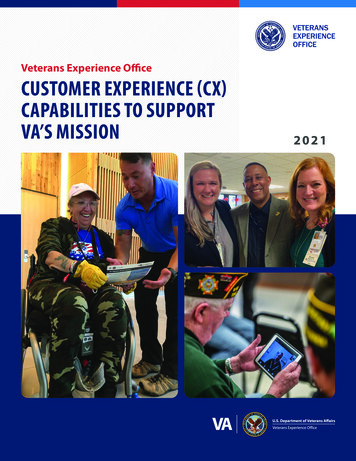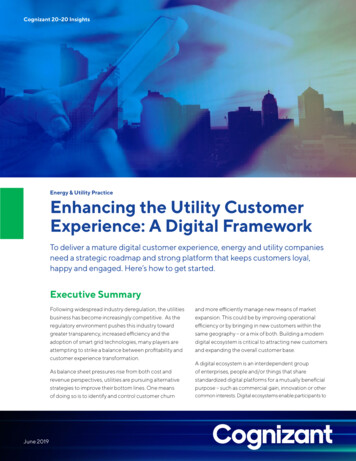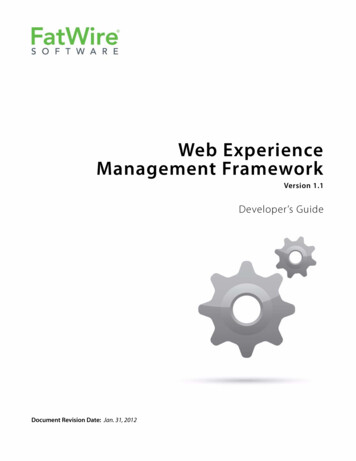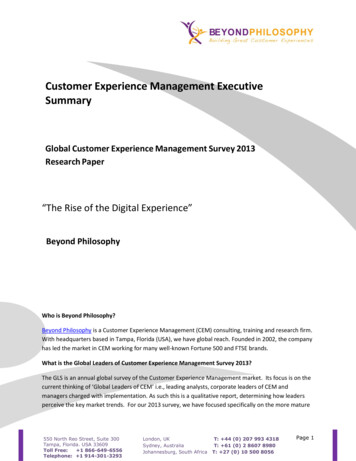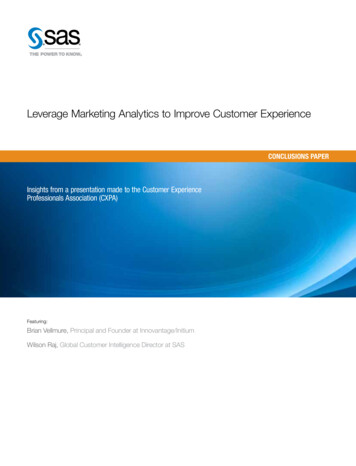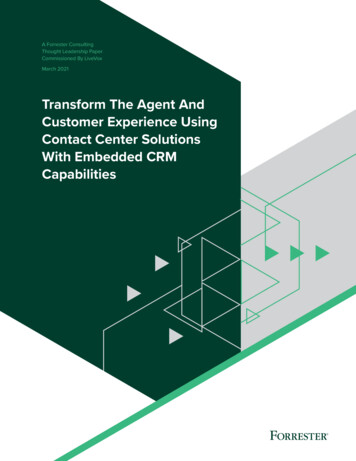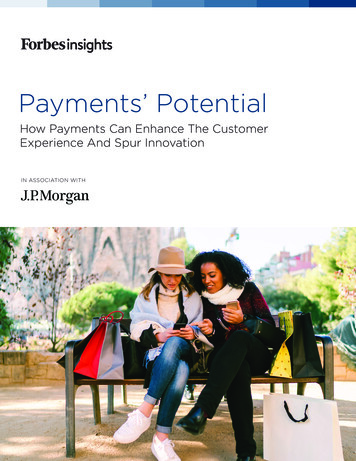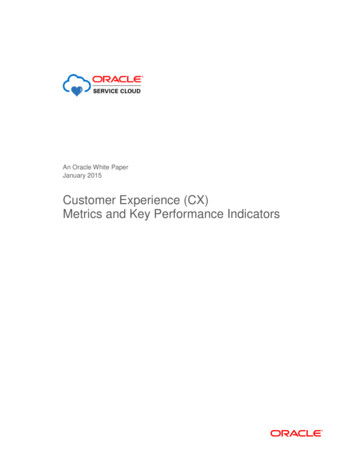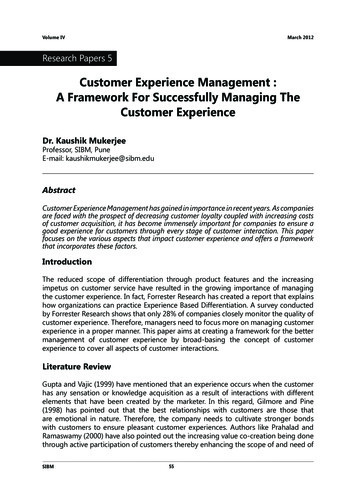
Transcription
Volume IVMarch 2012Research Papers 5Customer Experience Management :A Framework For Successfully Managing TheCustomer ExperienceDr. Kaushik MukerjeeProfessor, SIBM, PuneE-mail: kaushikmukerjee@sibm.eduAbstractCustomer Experience Management has gained in importance in recent years. As companiesare faced with the prospect of decreasing customer loyalty coupled with increasing costsof customer acquisition, it has become immensely important for companies to ensure agood experience for customers through every stage of customer interaction. This paperfocuses on the various aspects that impact customer experience and offers a frameworkthat incorporates these factors.IntroductionThe reduced scope of differentiation through product features and the increasingimpetus on customer service have resulted in the growing importance of managingthe customer experience. In fact, Forrester Research has created a report that explainshow organizations can practice Experience Based Differentiation. A survey conductedby Forrester Research shows that only 28% of companies closely monitor the quality ofcustomer experience. Therefore, managers need to focus more on managing customerexperience in a proper manner. This paper aims at creating a framework for the bettermanagement of customer experience by broad-basing the concept of customerexperience to cover all aspects of customer interactions.Literature ReviewGupta and Vajic (1999) have mentioned that an experience occurs when the customerhas any sensation or knowledge acquisition as a result of interactions with differentelements that have been created by the marketer. In this regard, Gilmore and Pine(1998) has pointed out that the best relationships with customers are those thatare emotional in nature. Therefore, the company needs to cultivate stronger bondswith customers to ensure pleasant customer experiences. Authors like Prahalad andRamaswamy (2000) have also pointed out the increasing value co-creation being donethrough active participation of customers thereby enhancing the scope of and need ofSIBM55
Volume IVMarch 2012managing customer experiences. In fact, Cova (1996) goes a step further to state thatconsumers seek to become a part of the experience instead of merely encounteringproducts and services and wish to have a more inclusive role. This has also beenpointed out by Willmott and Nelson (2003) - the mindset of customers has changedwhereby they seek experiences instead of being content with a mundane transactionalrelationship with the company.The consumption experience has been defined by Holbrook and Hirschman (1982) as‘a personal occurrence, often with important emotional significance, founded on theinteraction with stimuli which are the products or services consumed’. The aspect ofexperience has become so important for consumers that Pine and Gilmore (1998) havementioned that ‘we will increasingly pay companies to stage experiences for us just aswe now pay companies for services we once delivered ourselves, goods we once madeourselves, and commodities we once extracted ourselves’.Taking a cue from the importance ascribed to managing the customer experience,various researchers have conducted studies to highlight certain aspects of customerexperience management. Pullman and Gross (2003) have pointed out the importanceof various emotions in a specific service setting. Stuart-Menteth, Wilson, and Baker(2006) have highlighted the importance of managing the multi-channel experienceproperly while Jenkinson (2006) has drawn attention to the importance of informationin managing the customer experience. Berry, Carbone and Haeckel (2002) haveadopted a comprehensive approach in their research and pointed out the necessity ofconducting an experience audit. The authors have mentioned the need for undertakinga holistic effort at managing customer experience instead of making improvements incertain ‘pockets’. However, researchers have not provided a framework that can serveas a guide for managing the customer experience in a holistic manner. This paper aimsat creating such a framework based on the proposed aspects of customer experienceand conducting an analysis that takes into account the experience managementpractices of various companies.MethodologyThis paper would analyse customer experiences across the following categories: Impact on Senses Impact of Processes Impact of Communication Impact of Expertise Impact on RelationshipThe analysis would be done under each of these categories considering the practicesof various companies and result in the creation of a framework that can be used bymanagers for successfully managing the customer experience. These categories canalso be used to create the ‘Customer Experience Pyramid’ that depicts the hierarchicallevel of the various categories of customer experiences. Companies need to work onthe customer’s experience by focusing on the base of the pyramid first and then goingSIBM56
Volume IVMarch 2012up the hierarchical levels to reach the relationship experience management stage.I) Customer Experience - Impact on SensesAt the most basic level, the sensory experience has to create the right impact. Schmitt(1999) has mentioned about ‘SENSE marketing’ which involves the use of suitablemusic, colour, sound effects etc. to create the right stimulus. According to Schmitt, theaspect of ‘FEEL marketing’ takes into account the feelings aroused in the customersas a result of the stimuli. The impact on senses can be categorized into visual impact,auditory impact, and olfactory impact.1) Visual Impact: Essentially focusing on the visual aesthetics by ensuring a suitabledécor and furnishings. The visual impact of the logo and the signage that is viewedby customers should be created in a manner that ensures a pleasant experienceand puts the customer in the right mood. The visual impact should serve toinitiate a bond with the customer and apart from the basic function of enablingdifferentiation from the competition; a kind of harmony should emerge betweenthe customer and the organization. This is being initiated by a number of banks inIndia where the leading private banks like ICICI, HSBC, HDFC had taken the lead.Thereafter, public sector banks like Bank of Baroda, Union Bank of India etc. havealso undertaken facelifts for ensuring proper visual impact. The aesthetics are alsoimportant in the case of products and not only for services. For example, the iPodhas been a great success not only because of its storage capacity but also the lookand feel of the product. It has been regarded as a ‘cool’ product to own and flaunt– especially among the young population. In the mobile phone segment, Motorolahas been able to gain market share after the launch of visually appealing productslike the MotoRAZR and the MotoPEBL.2) Auditory And Olfactory Impact: Among the various aspects of sensoryexperiences, the impact on the auditory and olfactory senses assumes greatimportance especially in the case of services. The contact with customers is moreprolonged as in the case of airlines, entertainment complexes, and shopping malls.At times, the impact can result in an unpleasant customer experience as is evidentat the railway stations in India. On the other hand, airlines like Kingfisher Airlineshave taken the effort of installing personal entertainment systems even for theireconomy class customers to ensure that the sensory experience is enjoyable. In fact,Kingfisher Airlines has also ensured that the visual appeal of the aircraft cabin resultsin a superior customer experience. Likewise, an airline like Jet Airways ensure thatthe cabin is pleasant smelling and the fragrance used is very distinctive wherein thecustomer can distinguish the interior of the airline from other airlines on the basisof the olfactory impact. Similarly, luxury hotels like the Taj Group ensure that softmusic is audible inside the hotel lobby and the corridors while the use of suitablefragrances ensures a pleasant olfactory impact.The importance of the sensory experience in the context of customer experiencemanagement can be understood by taking into account the example of Barista orStarbucks. Though coffee and the various fast food items these joints sell are availableelsewhere at a fraction of the price, customers prefer paying a premium owing tothe superior experience offered by them. The superior sensory experience is createdSIBM57
Volume IVMarch 2012through suitable visual, auditory and olfactory impact. The sensory experience is oneof the components that help to create the total customer experience for the up marketfood joints like Barista and Starbucks.II) Impact of Processes on Customer ExperienceThe process followed during interactions that the customer undergoes in the course ofpurchase and usage of a product/service results in shaping the customer’s experience.Chase and Dasu (2001) have pointed out that the key elements in this regard aresequence and duration. Deighton (1992) has compared experience design to story-liketime pattern that is similar to episodes in human life.1) Method of Interaction: The processes that are followed for interfacing with thecustomer need a suitable design. The method of interaction should be convenientand easy for customers. Banks enable customers to access the services throughmultiple channels – websites, ATMs, retail counters, phone banking etc. Theprocesses should suit the customer’s needs. Therefore, the tracking of customerbehaviour and evaluation of processes from the point of view of the customerexperience need to be done. Companies like Dell regularly track the time thatcustomers are kept on hold after they have called the call centre with servicerequests. However, some banks using the IVR (Interactive Voice Response) methodresults in irritation for the customers owing to the complicated menu. Anotherimportant aspect that is important is to ensure that customers get a seamlessview of the company. Generally, companies comprise of departments that tendto work as ‘silos’ wherein the customer needs to deal with multiple departmentsand sometimes these departments even work at cross purposes. These factors canresult in unpleasantness in the customer’s experience and sometimes too muchharassment can lead to frustration and disgust. The governmental departments inIndia are known for causing such situations. Seybold (2005) has pointed out theneed for a proper organizational culture and structure that fosters the creationof a good customer experience. Apart from the facilitation, the author also drawsattention to the aspect of accountability mechanisms that would ensure that theempowerment of personnel is used in the right manner for fostering a bettercustomer experience.2) Unified Customer View: A seamless organization would require sharing of dataacross departments. The integration of data from the various departments anddivisions can help to create a unified view of the customer. This will ensure that thereis no duplication of efforts and the same customer is not targeted improperly. TheStandard Life Group in the UK comprised of four main companies – life assurance,general insurance, banking, and healthcare. However, the data on customers weremaintained separately and this resulted in failure to identify marketing opportunities.The multiple systems followed within the same company became hurdles forsharing of data. But once the data sharing was initiated, it resulted in noteworthybenefits to employees across the organization. Goldsmith (1999) suggested thatpersonalization should be incorporated as the eighth P in the services marketingmix. To enable personalization of offerings for customers, a unified customer viewis very essential. Hewlett Packard (HP) has created newsletters for customers aftertaking into account how technology-savvy the individual customer is and alsoSIBM58
Volume IVMarch 2012the interest of the customer for certain products. In this way, the personalizationenables a more useful customer experience wherein the customer’s individualrequirements are met better by the company. Amazon.com was able to offer abetter customer experience compared with established book retailers like Barnes& Noble through ensuring a unified customer view and proper personalization.The customer was treated as an individual wherein her needs and interests were offoremost importance to Amazon and was manifested during the interactions withcustomers through the website.3) Tools for Enabling Processes: The process experience can be improved withthe use of modern tools. The use of IT for enabling better customer experiencehas received considerable attention. Dardan, Stylianou, and Kumar (2006) haveconducted research on customer related IT investments and mention that theyhave considered the investments that were made with the intention of enhancingthe customer experience by increasing customer satisfaction. Prahalad andRamaswamy (2004) have highlighted the need of co-creating value throughcustomer involvement. Dell had used this effectively to enable personalization ofPCs wherein customers could configure their computers based on their individualrequirements. The suitable tools for enabling the processes were key to thesuperior customer experience. In the case of Dell, the website dell.com servedthe purpose along with the call centres. Investments in the latest technology canhelp in ensuring that customers’ experience gets enhanced through superior valuedelivery. The mobile telephony service provider Airtel signed a 100 million dealwith IBM for developing, operating and managing the service delivery platform.By investing in the proper tools, the service delivery and customer experience areenhanced. Likewise, entertainment and hospitality major Harrah’s invested in SASdatawarehousing solutions to understand customer behaviour better and createpersonalized offerings for loyal customers.III) Impact of Communication on Customer ExperienceIn the modern age of multi-channe
Customer Experience Management has gained in importance in recent years. As companies . are faced with the prospect of decreasing customer loyalty coupled with increasing costs of customer acquisition, it has become immensely important for companies to ensure a good experience for customers through every stage of customer interaction. This paper focuses on the various aspects that impact .
